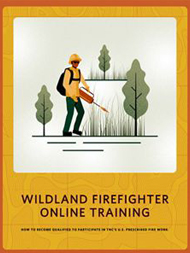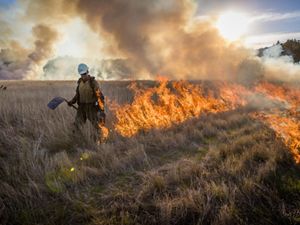Restoring Fire to Wisconsin's Native Landscapes
Fire is used to safely restore native habitats and provide many benefits to people and nature.
Want more stories like this?
Sign up for our monthly Nature News email!
Before Europeans settled in Wisconsin, about 10 million acres, or one-third of the state, burned on a regular basis. Some fires in Wisconsin were caused by lightning strikes, while many more were started by Native Americans who burned to clear the land for agriculture, improve grazing and forage for game species, direct game migration, and clear brush to ease travel or prevent hostile forces from approaching unnoticed.
Many Wisconsin trees and plants are fire-dependent and need fire every 3 to 25 years to thrive. Trees, such as jack pines, have cones that require heat to open and release seeds for regeneration. The caterpillars of the endangered Karner blue butterfly only feed on the leaves of wild lupine, a plant that depends on fire to set back encroaching forests and encourage lupine flowering and growth.
Fire provides many benefits
The Nature Conservancy (TNC) supports the safe and ecologically appropriate use of fire to maintain Wisconsin’s diversity of plant and animal life. Here are a few of the many benefits that fire provides to people and nature:
- Prescribed (or controlled) fire, oftentimes in combination with grazing, can be used to control brushy vegetation and invasive species like multiflora rose and honeysuckle that are problematic for prairie and other grassland managers.
- Forest managers use fire to keep forests healthy by reducing dead vegetation, killing forest pests, controlling invasive species, and stimulating the regeneration of desired tree species such as oaks.
- Regular prescribed fire can reduce the intensity of a wildfire. Without fire, dead trees, leaf litter, and pine needles build up over time providing lots of fuel. If a wildfire should occur, it will be much more severe and harder to control where a lot of fuel has built up.
- As Native Americans did before settlers arrived and continue to do today, land managers use fire to maintain grasslands, forests, and wetland habitats for wildlife including turkey and other game species by modifying cover and food quality and volume.
Download
-
 Wildland Firefighter Training
Wildland Firefighter TrainingInterested in helping out on TNC’s prescribed burns? Find out how to get certified in this downloadable guide!
DOWNLOAD
Fire is safe!
Prescribed fire is conducted by a team of highly skilled and experienced professionals and volunteers. A “burn boss” organizes and supervises the event around a written plan and schedule. Strict safety procedures provide for the safety of the crew, nearby residents, and private property. Conditions such as weather, wind, and humidity must be right before a fire is lit.
Some crew members will light a line of fire using drip torches. Others drive trucks or ATVs carrying equipment and water to be used to monitor the burn.
Native plants rebound
After a controlled burn, blackened fields quickly revive with new, green life. Big bluestem, purple milkweed, and wild lupine are among the many species that thrive on fire. Indeed, hundreds of Wisconsin’s plant species would be lost without it.
Oak savannas are some of the most endangered habitats in North America. Only a few thousand acres of the original 5 million acres of oak savanna that once covered Wisconsin exist today. Oaks are fire resistant trees, especially bur and white oaks, and won’t tolerate a lot of shade. Without fire, oaks are not able to compete with maples and other shade tolerant tree species, and eventually those species will take over the forest.
There are, however, many areas where oak savannas can be restored, and returning fire to these rare plant communities is vital to their restoration.
Fire-Dependent Landscapes of Wisconsin
Fire is necessary for the health of some native habitats (from left to right): Prairies at Spring Green Preserve and Thomson Memorial Prairie, a wetland at Central Sands Forest and Barrens, oak forests at Hemlock Draw Preserve in the Baraboo Hills.




Fire at Nature Conservancy preserves
TNC owns approximately 30,335 acres of conservation land in Wisconsin, more than half of which is fire dependent. A few of our preserves that depend on prescribed fire include:
- Oak openings and wetlands at Lulu Lake Preserve in the Mukwonago River Watershed
- Grasslands at the Military Ridge Prairie Heritage Area in Dane and Iowa counties
- Prairie habitat at Spring Green Preserve in Sauk County
- Oak woodlands in the Baraboo Hills in Sauk County
- Central Sands Forest and Barrens in Adams County

Good fire takes teamwork
With many government agencies, private landowners, and non-profits like TNC working to conserve Wisconsin’s lands and waters with limited resources, it is important that we work together. TNC works with agency partners through the Wisconsin Prescribed Fire Council and the Tallgrass Prairie and Oak Savanna Fire Science Consortium to share information, provide training opportunities, and implement burns collaboratively.
Collectively, the prescribed fire efforts of TNC and other organizations and agencies across the state result in more than 50,000 acres burned annually in Wisconsin.
While that’s an improvement over the last 100 years, when fire suppression was prioritized, much remains to be done. More than 3 million acres of intact, existing habitat in Wisconsin are fire dependent. To effectively manage that many acres, Wisconsin needs to burn 750,000 acres a year. Making meaningful progress towards that need will require fostering greater support and resources for prescribed fire.
TNC’s goal is to increase the pace and scale of fire in Wisconsin, which cannot be accomplished alone. The collective effort of partners like the U.S. Forest Service, Wisconsin DNR, U.S. Fish & Wildlife Service, counties, tribes, and private landowners working together achieves more than can be done by one entity alone. TNC is committed and poised to foster and support innovative, cross-boundary collaborations to collectively advance fire work across the state.

Prescribed fire is a valuable tool to help preserve the diversity of life on Earth – now and for future generations. Have we kindled your interest? If so, you can learn more about fire with the click of your mouse:





